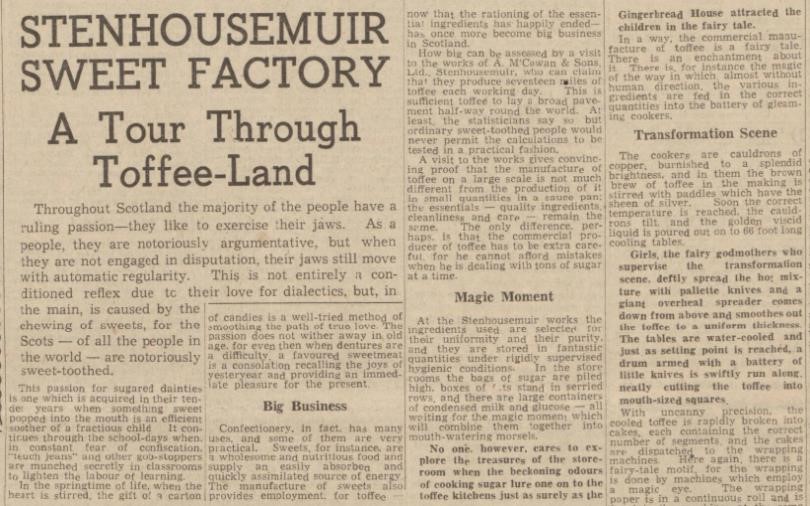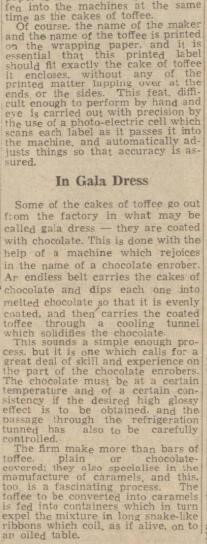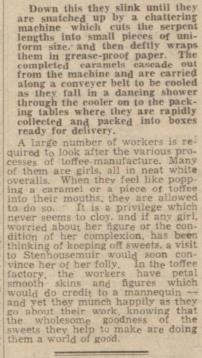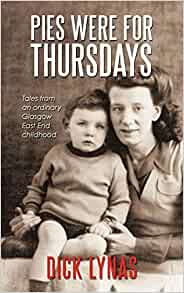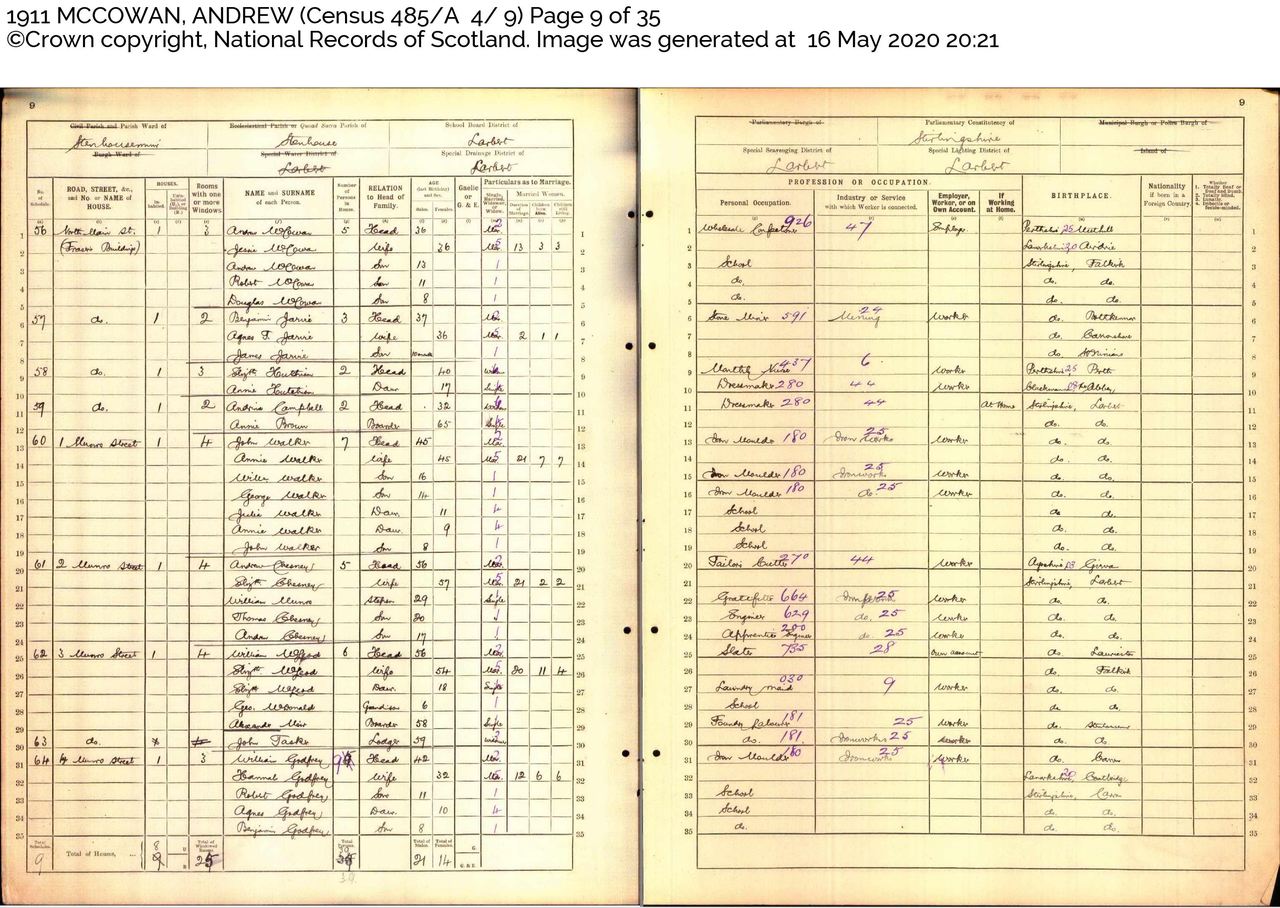Most people have heard of McCowan’s Highland Toffee, produced in Stenhousemuir, but few know that it was once advertised as “wholesome and toothsome.” You can learn more about how they developed their identity as healthy and 100% Scottish.
In the Falkirk Herald from December 1954 it is written that “Throughout Scotland the majority of the people have a ruling passion – they like to exercise their jaws” (p.5).
fields['text']) echo $section->fields['text']; ?>
Although I think the author of this statement may be talking about many Scot’s love for a natter, it is equally true that a McCowan’s toffee bar would present a chewing challenge to the jaws (and fillings) of anyone indulging in it.
Toffee, sugar and sweets have a great history in Scotland, and particularly in the Forth Valley. Located near to docks in Grangemouth, and with ports in Glasgow and Edinburgh easily accessed by the canal network, sugar and other goods imported from all corners of the world could be easily transported to the area throughout the 20th century.
Included in the Falkirk Herald from July 1925 is a contribution from a reader named Vera Boast. Her recipe is for toffee and makes use of some of the ingredients that would be moved along these transport routes. The reader is advised to melt 1 oz. butter, mix with ½ lb treacle and ½ lb of moist sugar and bring the mix to a boil for 10 minutes, and to then pour it into a buttered tin (Boast 1925 4). You can try this recipe yourself by going to our “McCowan’s Tasty Toffee Recipe” video.
Wholesome and Toothsome
Around the time that the recipe above was published Andrew McCowan began selling little toffee bars, which became known as McCowan’s highland toffee, that were manufactured in Stenhousemuir. McCowan was initially a wholesale distributor of confectionary, beginning in 1907 (Bloom 1935 52.) His company grew, and later inhabited the McCowan’s toffee factory (Bloom 1935 52.)
In contrast to contemporary vox populi, a profile of the McCowan’s factory in 1954 described McCowan’s highland toffee bars as being:
“a wholesome and nutritious food [that] supply an easily absorbed and quickly assimilated source of energy" (Falkirk Herald 1954 52).
fields['text']) echo $section->fields['text']; ?>
The article goes on to describe the McCowan factory workers as having “petal smooth skins and figures which would do credit to a mannequin” which is attributed to their freedom to “munch” the sweets as they were being made (Falkirk Herald 1954 52). Advertising related to McCowan’s over many generations, largely in newspapers, show that the company prided itself on the healthfulness and wholesomeness of their products.
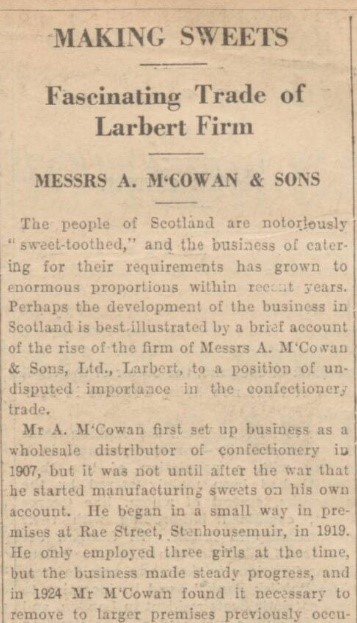

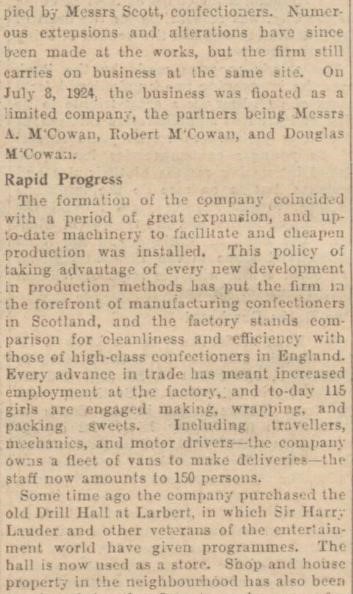

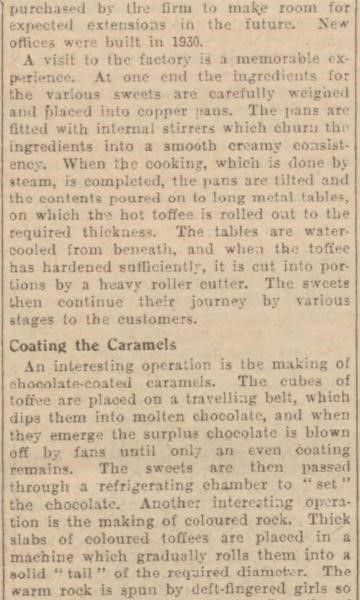

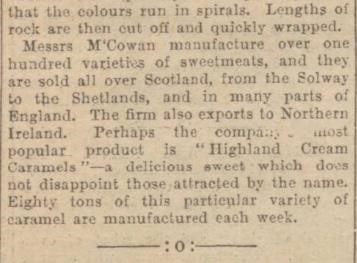

Rationing
During wartime, the company was affected by sugar rationing, with adverts in 1942 and 1945 noting that Highland Toffee was for sale in “short supply” but still “as toothsome a morsel as o’er whetted a war-time appetite” (Edinburgh Evening News 1942 2 and Daily Record 1942 3.) Other adverts noted that McCowan’s Highland toffee was “not only nice ― it’s nourishing” (Falkirk Herald 1942 8), in a bid to tempt even the most abstemious!
The limitations of black and white print advertising likely influenced the information and imagery included in the McCowan company adverts. The small adverts dotted throughout Scottish newspapers feature many of the same characteristics and continued to be used until the closure of the factory. A proud declaration of the name of the company and text noting the popularity and tastiness of their product feature most prominently and in almost all of the adverts identified. A smaller number of the adverts mention that the products were made in Scotland, include an image of a highland cow, sponsor a cause, or make note that McCowan products are of quality and have been hygienically manufactured.
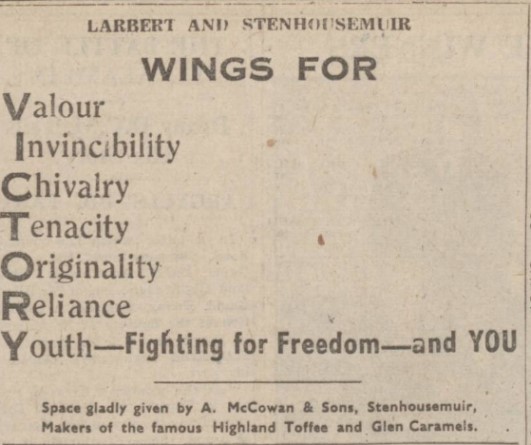

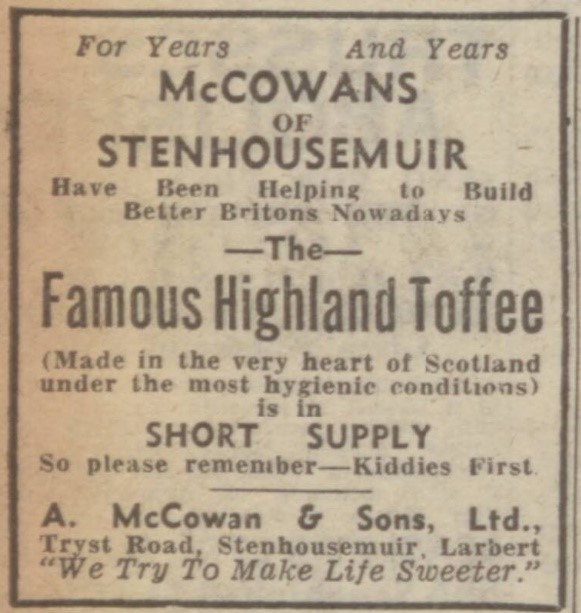

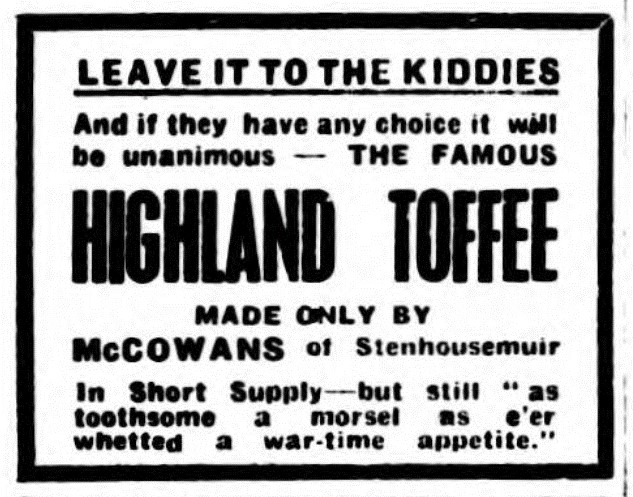

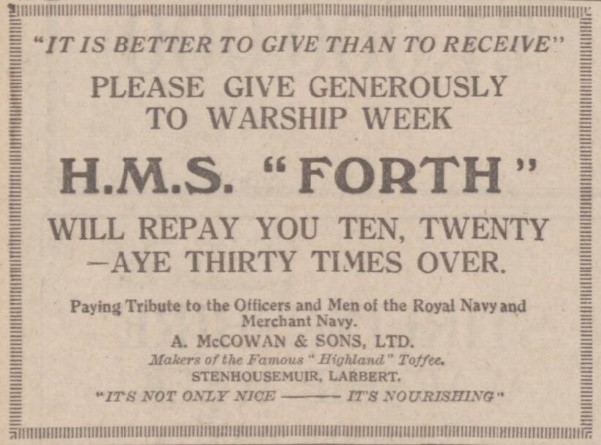

Scotland Idealised
An idealised, bucolic view of Scotland was also consciously represented in the imagery used in the company’s packaging and representation of its products. The highland cow depicted on the Highland toffee wrapper and within McCowan adverts were unlikely to be found around the area of Stenhousemuir where the toffee was made, but it was used to suggest a traditional product by using imagery relating to the cattle selling trysts historically held in the area (a connection the company appear to have been keen to promulgate). The use of this imagery and the presentation of the company and their products as wholesome and of great quality can be argued to have been a key part of the company’s success.
In their advertising the company styled their product as being their “Famous “Highland” Toffee” (Falkirk Herald 1942 8). At various points the product was alternately called Buttermilk Dainties and Highland Cream Caramel. In 1935 it was reported that “Eighty tons of this particular caramel are manufactured each week” (Bloom 1935 52). McCowan’s went on to make several more adventurous sweets including Wham and Irn Bru bars, but Highland toffee was their iconic product.
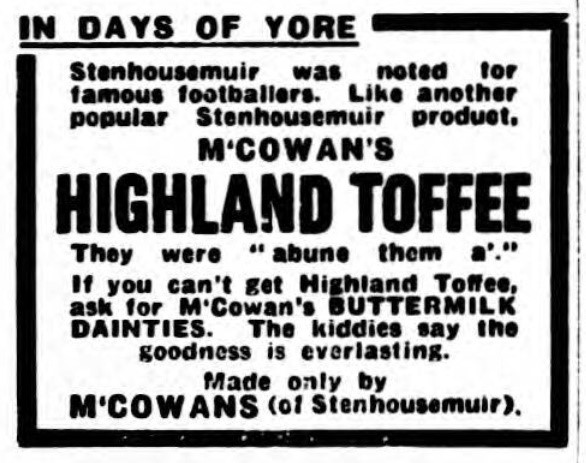

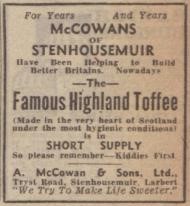

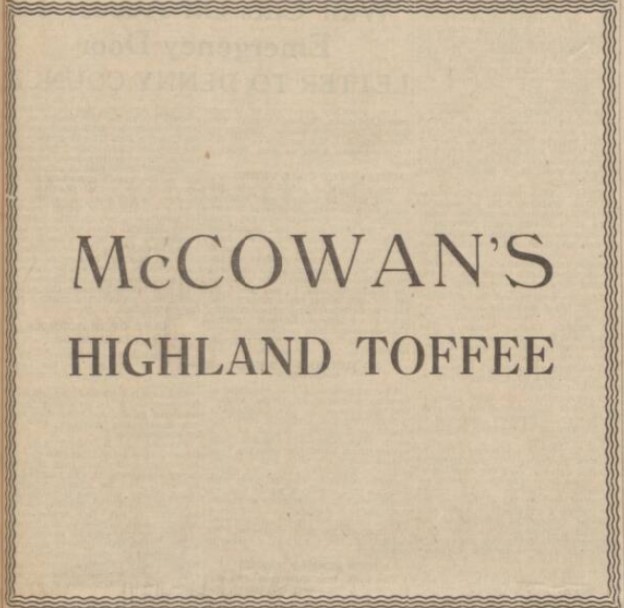

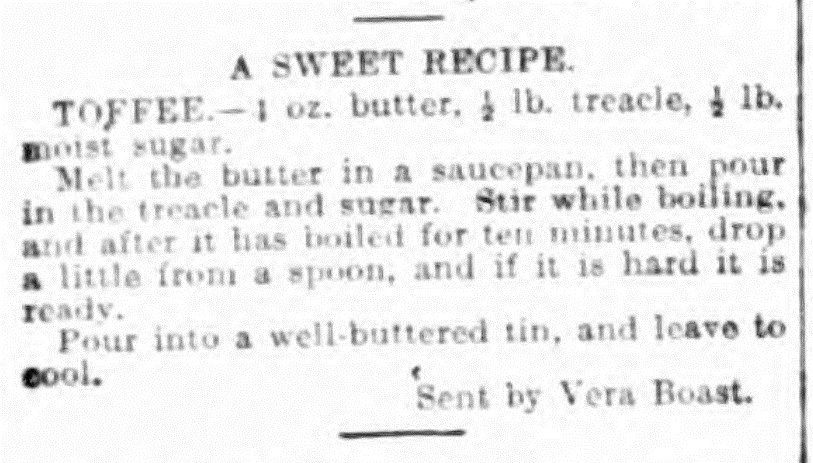

Philanthropy
They continued to present this character of the company through advertising related to several causes. McCowan’s sponsored many local events, including charities, the local Operatic Society (which you can read about in our “Recollections of Larbert Opera” story), newspaper and sporting competitions, and the war effort. The company regularly sponsored (and advertised on the programmes) of productions by the Larbert amateur dramatic society. In 1943 the company sponsored a “Wings for Victory” advert in the Falkirk Herald. In 1942 another advert in the Falkirk Herald was taken out by the company asking people to give generously to warship week, and writing that they were “Paying tribute to the Officers and men of the Royal Navy and Merchant Navy” (Falkirk Herald 1942 8).
These causes (and possibly the prestige related supporting them) appear to have been important to the company, with a 1942 advert in the Trinity Mirror noting that “For years and years McCowan’s of Stenhousemuir have been helping to build better Britains’ (Daily Record 1942 3).
By Rowan Berry, Great Place volunteer.
